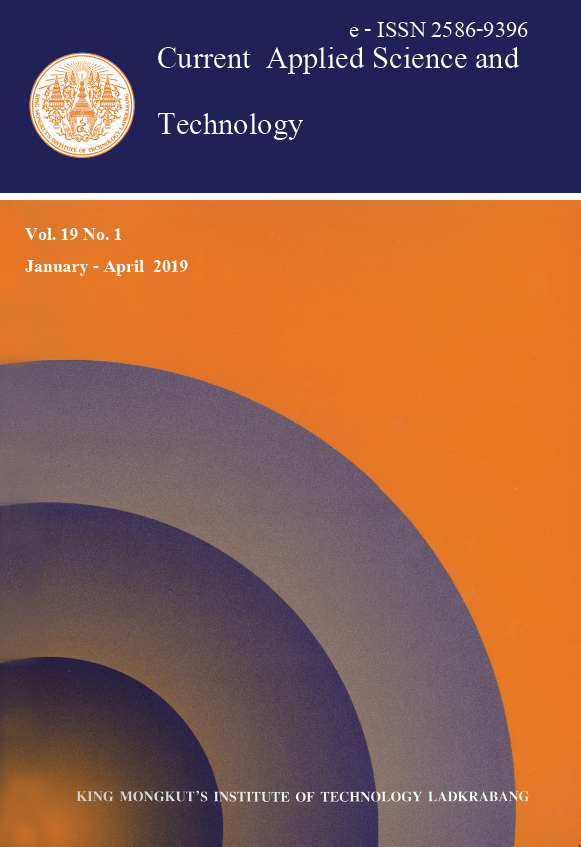Porous Carbon Adsorbent from Humin Derived from Thai Leonardite for Methylene Blue Dye Adsorption
Main Article Content
Abstract
Leonardite is by-product from lignite mine found in northern Thailand. Leonardite is generally known as natural source of humic substances. Humic substances can be divided into three major fractions, i.e. humin, humic acids and fulvic acids. These fractions can be extracted by using solution adjusted to different acid alkaline (pH levels). Humin is a major product that can be extracted from Thai leonardite and it is over 80% yield of product. The morphology of humin is non-conductive bulk material with few porous structures. It can be used as adsorbent for dye adsorption or heavy metal and used as catalyst supporter. The synthesis of porous carbon from humin via carbonization process was investigated in this research. Humin was carbonized at different temperatures and characterized by SEM, FTIR, UV-Vis and BET. Porous carbon from humin was used in methylene blue dye adsorption. The result indicates that the particle size of humin was decreased with well-dispersed and non-agglomerate humin was observed in higher carbonization temperature. The adsorption capacity of humin was increased with increasing of temperature up to 700ºC and decreased at 900ºC according to surface area and porosity results. Although the carbon content of humin was increased at higher temperature, the function group used as adsorbent was decomposed.
Keywords: leonardite; humic substance; humin and carbon absorbent
Corresponding author: E-mail: [email protected]
Article Details
Copyright Transfer Statement
The copyright of this article is transferred to Current Applied Science and Technology journal with effect if and when the article is accepted for publication. The copyright transfer covers the exclusive right to reproduce and distribute the article, including reprints, translations, photographic reproductions, electronic form (offline, online) or any other reproductions of similar nature.
The author warrants that this contribution is original and that he/she has full power to make this grant. The author signs for and accepts responsibility for releasing this material on behalf of any and all co-authors.
Here is the link for download: Copyright transfer form.pdf
References
Metivier-Pignon, H., Faur-Brasquet, C. and Cloirec, P.L., 2003. Adsorption of dyes onto activated carbon cloths: approach of adsorption mechanisms and coupling of ACC with ultra filtration to treat coloured wastewaters. Journal of Separation and Purification Technology, 31, 3–11.
Ghodbane, H., Hamdaoui, O., 2009. Intensification of sonochemical decolorization of anthraquinonic dye acid blue 25 using carbon tetrachloride. Journal of Ultrasonics Sonochemistry, 16(4), 455-461.
Rafatullah, M., Sulaiman, O., Hashim, R. and Ahmad, A., 2010. Adsorption of methylene blue on low-cost adsorbents: a review. Journal of Hazardous Materials, 177, 70–80.
Dabrowski, A., 2001. Adsorption from theory to practice. Journal of Advances in Colloid and Interface Science, 93, 135–224.
Gayatri1, S. L. and Ahmaruzzaman, Md., 2010. Adsorption technique for the removal of phenolic compounds from wastewater using low-cost natural adsorbents. Journal of Science & Technology, 5(2), 157-166.
Mohammed, M.A., Shitu, A. and Ibrahim, A., 2014. Removal of methylene blue using low cost adsorbent: a review. Research Journal of Chemical Sciences, 4, 91-102.
Bailey, S.E., Olin, T.J., Bricka, M. and Adrian, D.D., 1999. A review of potentially low-cost sorbents for heavy metals. Journal of Water Research, 33, 2469–2479.
World Energy, 2016. World energy resource 2016, [online] Available at: https://www.worldenergy.org/data/resources
Teparut, C. and Sthiannopkao, S., 2011. Mae Moh Lignite Mine and Environmental Management. Journal of Geosystem Engineering, 14(2), 85-94.
Schwarzenbach, R.P., Gschwend, P.M. and Imboden, D.M., 1993. Environmental Organic Chemistry. New York : John Wiley & Sons Inc.
Janŏs, P., Michalek, P. and Turek, L., 2007. Sorption of ionic dyes onto untreated low- rank coal oxihumolite: a kinetic study. Journal of Dyes and Pigments, 74, 363-370.
Aiken, G.R., McKnight, G.R., Wershaw, R.L. and MacCarthy, P., 1985. Humic Substances in Soil, Sediment and Water : Geochemistry, Isolation and Characterization. New York: Wiley.
Berbara, R.L.L. and García, A.C., 2014. Humic substances and plant defense metabolism. In: P. Ahmed and M.D. Wani, eds. Physiological Mechanisms and Adaptation Strategies in Plants under Changing Environment. New York : Springer, pp. 297-319.
Garcia, D. and Cegarra, J., 1996. A comparison between alkaline and decomplexing reagents to extract humic acids. Journal of Fuel Processing Technology, 48, 51-60.

